
|

Poultry Industry Statistics and Reports
|
U.S. Broiler and Turkey Exports, January-June 2025
|
08/18/2025 |
|
 OVERVIEW OVERVIEW
Total exports of bone-in broiler parts and feet during January-June 2025 attained 1,505,298 metric tons, 8.3 percent lower than in January-June 2024 (1,641,279 metric tons). Total value of broiler exports increased by 0.2 percent to $2,259 million ($2,255 million).
Total export volume of turkey products during January-June 2025 attained 87,186 metric tons, 15.7 percent less than in January-June 2024 (103,393 metric tons). Total value of turkey exports increased by 13.2 percent to $343 million ($303 million).
Average unit price for the broiler industry is constrained by the fact that leg quarters comprise over 96 percent of broiler meat exports by volume (excluding feet). Leg quarters represent a relatively low-value undifferentiated commodity lacking in pricing power. Exporters of commodities are subjected to competition from domestic production in importing nations. Generic products such as leg quarters are vulnerable to trade disputes and embargos based on real or contrived disease restrictions. To increase sales volume and value the U.S. industry will have to become more customer-centric offering value-added presentations with attributes required by importers. Whether this will increase margins is questionable given that leg quarters are regarded as a by-product of broiler production. A more profitable long-term strategy for the U.S. industry would be to develop products using dark meat to compete with and displace pork and beef in the domestic retail and institutional markets. Due to a shortage and hence high price for beef presentations this transition is now evident.
HPAI is now accepted to be a panornitic affecting the poultry meat industries of six continents with seasonal and sporadic outbreaks. The incidence rate and location of cases in the U.S. has limited the eligibility for export from many plants depending on restrictions imposed by importing nations. Although there have not been any incident cases in the U.S. for three months a resurgence is anticipated in the Fall.
Uncertainty surrounding tariff policy is an added complication potentially impacting export volume in 2025. In the event of reduced exports, leg quarters would be diverted to the domestic market resulting in a depression in average value derived from a processed bird.
EXPORT VOLUMES AND PRICES FOR BROILER MEAT
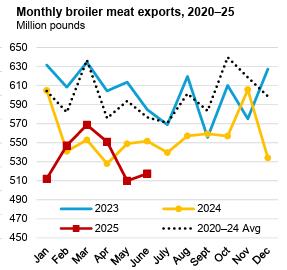 During January-June 2025 the National Chicken Council (NCC), citing USDA-FAS data, documented exports of 1,525,413 metric tons of chicken parts and other forms (whole and prepared), down 7.8 percent from January-June 2024. Exports were valued at $2,322 million, down 1.0 percent with a weighted average unit value of $1,522 per metric ton but up 9.5 percent over the corresponding six months in 2024. During January-June 2025 the National Chicken Council (NCC), citing USDA-FAS data, documented exports of 1,525,413 metric tons of chicken parts and other forms (whole and prepared), down 7.8 percent from January-June 2024. Exports were valued at $2,322 million, down 1.0 percent with a weighted average unit value of $1,522 per metric ton but up 9.5 percent over the corresponding six months in 2024.
The NCC breakdown of chicken exports for January-June 2025 by proportion and unit price for each category compared with the corresponding months in 2024 (with the unit price in parentheses) comprised:-
- Chicken parts (excluding feet) 95.1%; Unit value $1,410 per metric ton ($1,299)
- Prepared chicken 4.1%; Unit value $4,088 per metric ton ($4,212)
- Whole chicken 0.8%; Unit value $1,700 per metric ton ($1,650)
- Composite Total 100.0%; Av. value $1,522 per metric ton ($1,390)
The following table prepared from USDA data circulated by the USAPEEC, compares values for poultry meat exports during January-June 2025 compared with the corresponding months of 2024:-
|
PRODUCT
|
Jan.-June 2024
|
Jan.-June 2025
|
DIFFERENCE
|
|
Broiler Meat & Feet
|
|
|
|
|
Volume (metric tons)
|
1,641,279
|
1,505,198
|
-136,081 (-8.3%)
|
|
Value ($ millions)
|
2,255
|
2,259
|
+4 (+0.2%)
|
|
Unit value ($/m. ton)
|
1,374
|
1,501
|
+127 (+9.2%)
|
|
Turkey Meat
|
|
|
|
|
Volume (metric tons)
|
103,393
|
87,186
|
-16,207 (-15.7%)
|
|
Value ($ millions)
|
303
|
343
|
+40 (+13.2%)
|
|
Unit value ($/m. ton)
|
2,931
|
3,934
|
+1.003 (+34.2%)
|
COMPARISON OF U.S. CHICKEN AND TURKEY EXPORTS
JANUARY-JUNE 2025 COMPARED TO 2024
BROILER EXPORTS
Total broiler parts, predominantly leg quarters but including feet, exported during January-June 2025 compared with the corresponding months in 2024 declined by 8.3 percent in volume but value was up 0.2 percent. Unit value was 9.2 percent higher to $1,501 per metric ton.
During 2024 exports attained 3,251,000 metric tons valued at $4,689 million, down 10.5 percent in volume and down 1.1 percent in value compared to 2023. Unit value was up 10.7 percent to $1,442 per metric ton
Broiler imports in 2025 are projected to attain an inconsequential 67,000 metric tons (134 million lbs.) compared to 82,000 metric tons (180,000 million lbs.) in 2024
The top five importers of broiler meat represented 50.2 percent of shipments during January-June 2025. The top ten importers comprised 65.6 percent of the total volume reflecting concentration among the significant importing nations. Eighth-ranked China declined 55 percent in volume to 42,426 tons and 29 percent in value to $143 million over the first half of 2025 compared to the corresponding period in 2024
Nations gaining in volume compared to the corresponding period in 2024 (with the percentage change indicated) in descending order of volume with ranking indicated by numeral were:-
3. Philippines, (+46%); 5. Canada, (+23%); 10. Ghana, (+28%); 11. Haiti,(+22%);
12. Georgia, (+3%); 14. Dominican Republic, (+9%)
Losses during January-June 2025 offset the gains in exports with declines for:-
1. Mexico, (-2%); 2. Cuba, (-5%); 3. Taiwan, (-1%); 6. Guatemala, (-3%); 7.Viet Nam, (-19); 8. China, (-55%); 9. Angola, (-25%); 13. UAE, (-36%) and 15. Hong Kong, (-48%).
TURKEY EXPORTS
The volume of turkey meat exported during January-June 2025 declined by 15.7 percent to 87,186 metric tons from January-June 2024 but value was 13.2 percent higher to $343 million. Average unit value was 34.2 percent higher to $3,934 per metric ton.
Imports of turkey products attained 15,000 metric tons (33 million lbs.) in 2024 with a similar projection for 2025.
 It is important to recognize that exports of chicken and turkey meat products to our USMCA partners amounted to $1,264 million in 2021, $1,647 million during 2022, $1,696 in 2023 and $1,108 million over the first six-months of 2025. It will be necessary for all three parties to the USMCA to respect the terms of the Agreement in good faith since punitive action against Mexico or Canada on issues unrelated to poultry products will result in reciprocal action by our trading partners to the possible detriment of U.S. agriculture. This is especially important as all three nations have newly elected chief executives and administrations. It is important to recognize that exports of chicken and turkey meat products to our USMCA partners amounted to $1,264 million in 2021, $1,647 million during 2022, $1,696 in 2023 and $1,108 million over the first six-months of 2025. It will be necessary for all three parties to the USMCA to respect the terms of the Agreement in good faith since punitive action against Mexico or Canada on issues unrelated to poultry products will result in reciprocal action by our trading partners to the possible detriment of U.S. agriculture. This is especially important as all three nations have newly elected chief executives and administrations.
The emergence of H5N1strain avian influenza virus with a Eurasian genome in migratory waterfowl in all four Flyways of the U.S. during 2022 was responsible for sporadic outbreaks of avian influenza in backyard flocks and serious commercial losses in egg-producing complexes and turkey flocks but to a lesser extent in broilers. The probability of additional outbreaks of HPAI over succeeding weeks appears unlikely but outbreaks are expected to resume with fall migration of waterfowl. Incident cases affecting egg-production and turkey flocks will be a function of shedding by migratory and domestic birds and possibly free-living mammals and extension from dairy herds. Protection of commercial flocks at present relies on the intensity and efficiency of biosecurity including wild-bird laser repellant installations, representing investment in structural improvements and operational procedures. These measures are apparently inadequate to provide absolute protection, suggesting the need for preventive vaccination in high-risk areas for egg-producing, breeder and turkey flocks.
The application of restricted county-wide embargos following the limited and regional cases of HPAI in broilers with restoration of eligibility 28 days after decontamination has supported export volume for the U.S. broiler industry. Exports of turkey products were more constrained with plants processing turkeys in Minnesota, the Dakotas, Wisconsin and Iowa impacted. The future challenge will be to gain acceptance for limited preventive vaccination of laying hens and turkeys in high-risk areas accompanied by intensive surveillance. It is now accepted that H5N1 HPAI is panornitic in distribution among commercial and migratory birds across six continents. The infection is now seasonally or regionally endemic in many nations with intensive poultry production, suggesting that vaccination will have to be accepted among trading partners as an adjunct to control measures in accordance with WOAH policy.
The live-bird market system supplying metropolitan areas, the presence of numerous backyard flocks, gamefowl and commercial laying hens allowed outside access, potentially in contact with migratory and now some resident bird species, all represent an ongoing danger to the entire U.S. commercial industry. The live-bird segments of U.S. poultry production represent a risk to the export eligibility of the broiler and turkey industries notwithstanding compartmentalization for breeders and regionalization to counties or states for commercial production.

|
Updated USDA-ERS Poultry Meat Projection for August
|
08/17/2025 |
|
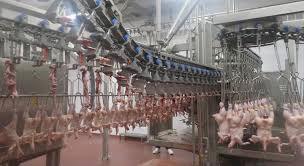 On August 18th 2025 the USDA-Economic Research Service released updated production and consumption data with respect to broilers and turkeys, covering 2024, a projection for 2025 and a forecast for 2026. On August 18th 2025 the USDA-Economic Research Service released updated production and consumption data with respect to broilers and turkeys, covering 2024, a projection for 2025 and a forecast for 2026.
The revised 2025 projection for broiler production is for 47,762 million lbs. (21.710 million metric tons) up 1.6 percent from 2024. USDA projected per capita consumption of 102.7 lbs. (46.7 kg.) for 2025, up 1.6 percent from 2024. Exports will attain 6,481 million lbs. (2.946 million metric tons), 3.0 percent below the previous year.
The 2026 USDA forecast for broiler production will be 48,150 million lbs. (21.886 million metric tons) up 0.8 percent from 2025 with per capita consumption up 0.1 lb. to 102.8 lbs. (46.7 kg). Exports will be 2.0 percent higher compared to 2025 at 6,610 million lbs. (3.005 million metric tons), equivalent to 13.7 percent of production.
Production values for the broiler and turkey segments of the U.S. poultry meat industry are tabulated below:-
|
Parameter
|
2024
(actual)
|
2025
(projection)
|
2026
(forecast)
|
Difference
2024 to 2025
|
|
Broilers
|
|
|
|
|
|
Production (million lbs.)
|
46,994
|
47,762
|
48,150
|
+1.6
|
|
Consumption (lbs. per capita)
|
101.1
|
102.7
|
102.8
|
+1.5
|
|
Exports (million lbs.)
|
6,680
|
6,481
|
6,610
|
-3.0
|
|
Proportion of production (%)
|
14.2
|
13.6
|
13.7
|
-4.2
|
|
|
|
|
|
|
|
Turkeys
|
|
|
|
|
|
Production (million lbs.)
|
5,121
|
4,791
|
5,121
|
-6.4
|
|
Consumption (lbs. per capita)
|
13.8
|
13.0
|
13.6
|
-5.8
|
|
Exports (million lbs.)
|
486
|
412
|
436
|
-15.2
|
|
Proportion of production (%)
|
9.5
|
8.6
|
8.5
|
-9.5
|
Source: Livestock, Dairy and Poultry Outlook released August 18th 2025
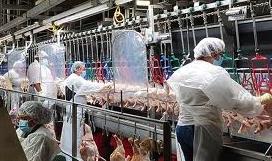 The August USDA report updated projection for the turkey industry for 2025 including annual production of 4,791 million lbs. (2.173 million metric tons), down 6.4 percent from 2024. Consumption in 2025 is projected to be 13.0 lbs. (5.9 kg.) per capita, down by 5.8 percent from the previous year. Export volume will attain 412 million lbs. (187,272 metric tons) in 2025. Values for production and consumption of RTC turkey in 2025 are considered to be realistic, given year to date data, the prevailing economy, variable weekly poult placements, production levels, losses from HPAI and inventories consistent with season. The August USDA report updated projection for the turkey industry for 2025 including annual production of 4,791 million lbs. (2.173 million metric tons), down 6.4 percent from 2024. Consumption in 2025 is projected to be 13.0 lbs. (5.9 kg.) per capita, down by 5.8 percent from the previous year. Export volume will attain 412 million lbs. (187,272 metric tons) in 2025. Values for production and consumption of RTC turkey in 2025 are considered to be realistic, given year to date data, the prevailing economy, variable weekly poult placements, production levels, losses from HPAI and inventories consistent with season.
The 2026 forecast for turkey production is 5,121 million lbs. (2.328 million metric tons) up an optimistic 6.9 percent from 2025 with per capita consumption up 4.6 percent to 13.6 lbs. (6.2 kg). Exports will be 5.8 percent higher than in 2025 to 435 million lbs. (197,728 metric tons) equivalent to 8.5 percent of production.
Export projections do not allow for a breakdown in trade relations with existing major partners including Mexico, Canada and China nor the impact of catastrophic diseases including HPAI and vvND in either the U.S. or importing nations

|
Updated USDA-ERS July Poultry Meat Projection
|
08/01/2025 |
|
 On July 17th 2024 the USDA-Economic Research Service released updated production and consumption data with respect to broilers and turkeys, covering 2024, a projection for 2025 and a forecast for 2026. On July 17th 2024 the USDA-Economic Research Service released updated production and consumption data with respect to broilers and turkeys, covering 2024, a projection for 2025 and a forecast for 2026.
The 2025 projection for broiler production is for 47,690 million lbs. (21.677 million metric tons) up 1.5 percent from 2024. USDA projected per capita consumption of 102.5 lbs. (46.6 kg.) for 2025, up 1.5 percent from 2024. Exports will attain 6,473 million lbs. (2.942 million metric tons), 3.1 percent below the previous year.
The 2026 USDA forecast for broiler production will be 48,100 million lbs. (21.864 million metric tons) up 0.9 percent from 2025 with per capita consumption up 0.2 lb. to 102.7 lbs. (46.7 kg). Exports will be 2.1 percent higher compared to 2025 at 6,610 million lbs. (3.005 million metric tons), equivalent to 13.7 percent of production.
Production values for the broiler and turkey segments of the U.S. poultry meat industry are tabulated below:-
|
Parameter
|
2024
(actual)
|
2025
(projection)
|
2026
(forecast)
|
Difference
2024 to 2025
|
|
Broilers
|
|
|
|
|
|
Production (million lbs.)
|
46,994
|
47,690
|
48,100
|
+1.5
|
|
Consumption (lbs. per capita)
|
101.1
|
102.5
|
102.6
|
+1.4
|
|
Exports (million lbs.)
|
6,680
|
6,473
|
6,681
|
-3.1
|
|
Proportion of production (%)
|
14.2
|
13.6
|
13.9
|
-4.2
|
| |
|
|
|
|
|
Turkeys
|
|
|
|
|
|
Production (million lbs.)
|
5,121
|
4,796
|
5,080
|
-6.3
|
|
Consumption (lbs. per capita)
|
13.8
|
13.0
|
13.5
|
-5.8
|
|
Exports (million lbs.)
|
486
|
405
|
435
|
-16.6
|
|
Proportion of production (%)
|
9.5
|
8.4
|
8.6
|
-11.6
|
Source: Livestock, Dairy and Poultry Outlook released July 17h 2025
The July USDA report updated projection for the turkey industry for 2025 including annual production of 4,796 million lbs. (2.180 million metric tons), down 6.3 percent from 2024. Consumption in 2025 is projected to be 13.0 lbs. (5.9 kg.) per capita, down proportionately by 5.8 percent from the previous year. Export volume will attain 405 million lbs. (184,090 metric tons) in 2025. Values for production and consumption of RTC turkey in 2025 are considered to be realistic, given year to date data, the prevailing economy, variable weekly poult placements, production levels, losses from HPAI and inventories consistent with season.

The 2026 forecast for turkey production is 5,080 million lbs. (2.309 million metric tons) up an optimistic 5.9 percent from 2025 with per capita consumption up an unsubstantiated 3.8 percent to 13.5 lbs. (6.1 kg). Exports will be 19.7 percent higher than in 2025 to 435 million lbs. (197,728 metric tons) equivalent to 8.6 percent of production.
Export projections do not allow for a breakdown in trade relations with existing major partners including Mexico, Canada and China nor the impact of catastrophic diseases including HPAI and vvND in either the U.S. or importing nations

|
Broiler Month
|
06/26/2025 |
|
Monthly Broiler Production Statistics, May 2024.
Broiler Chick Placements May-June 2025.
According to the June 18th 2025 USDA Broiler Hatchery Report, 1.260 million eggs were set over five weeks extending from May 17th 2025 through June14th 2025 inclusive. This was 1.2 percent higher compared to the corresponding period in 2024.
 Total chick placements for the U.S. over the five-week period amounted to 967.67 million chicks. Claimed hatchability for the period averaged 79.1 percent for eggs set three weeks earlier. Each 1.0 percent change in hatchability represents approximately 1.92 million chicks placed per week and 1.82 million broilers processed, assuming five percent culls and mortality and within the current range of weekly settings. Total chick placements for the U.S. over the five-week period amounted to 967.67 million chicks. Claimed hatchability for the period averaged 79.1 percent for eggs set three weeks earlier. Each 1.0 percent change in hatchability represents approximately 1.92 million chicks placed per week and 1.82 million broilers processed, assuming five percent culls and mortality and within the current range of weekly settings.
Cumulative chick placements for the period January 7th through December 30th 2024 amounted to 9.67 billion chicks. For January 4th through June 14th 2025 chick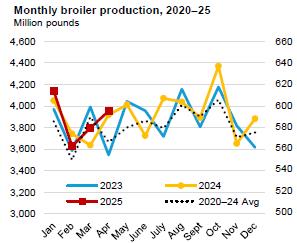 placements attained 4.61 billion, up one percent from the corresponding week in 2023. placements attained 4.61 billion, up one percent from the corresponding week in 2023.
According to the June 23rd 2025 edition of the USDA Chickens and Eggs, pullet breeder chicks hatched and intended for U.S. placement during May 2025 amounted to 8.17 million, down 0.7 percent (58,000 pullet chicks) from May 2024 and 7.9 percent (699,000 pullet chicks) less than the previous month of April 2025. Broiler breeder hen complement attained 60.30 million on May1st 2025, 2.0 percent (1.23 million hens) less than on May 1st 2024.
Broiler Production May 2025
As documented in the June 19th 2025 USDA Weekly Poultry Slaughter Reports for the processing week ending June 14th 2025, 170.9 million broilers were processed at 6.50 lbs. live. This was 3.6 percent more than the 165.0 million processed during the corresponding week in June 2024. Broilers processed in 2025 to date amounted to 3,963 million, 1.9 percent more than for the corresponding period in 2024.
Ready to cook (RTC) weight for the most recent week in June was 852.2 million lbs. (387,364 metric tons). This was 4.5 percent more than the 815.2 million lbs. during the corresponding week in June 2024. Dressing percentage was a nominal 76.0 percent. For 2025 to date RTC broiler production attained 19.777 million lbs. (8.99 million metric tons). This quantity was 3.4 percent more than for the corresponding period in 2024.
The USDA posted live-weight data for the past week ending June 14th and YTD 2025 included:-
|
Live Weight Range (lbs.)
|
<4.25
|
4.26-6.25
|
6.26-7.25
|
>7.76
|
|
Proportion past week (%)
|
15
|
27
|
26
|
32
|
|
Change from 2020 YTD (%)
|
-7
|
+4
|
-3
|
+10
|
May 2025 Frozen Inventory
According to the June 25th 2025 USDA Cold Storage Report, issued monthly, stocks of broiler products as of May 31st 2025 compared to May 31st 2024 showed differences with respect to the following categories:-
- Total Chicken category attained 754.4 million lbs. (342,905 metric tons) corresponding to approximately one week of production based on recent weekly RTC output. The May 31st 2025 inventory was up 1.0 percent compared to 747,092 million lbs. (389,587 metric tons) on May 31st 2024 and up 0.1 percent from the previous month of April 2025.
- Leg Quarters were down by 2.7 percent to 51.0 million lbs. compared to May 31st 2024 consistent with the data on exports. Inventory was down 6.5 percent from April 2025. Given the trend in inventory of leg quarters it is evident that this category continues to be shipped in varying quantities as the principal (97 percent) chicken export product to a number of nations with The top five importers representing 50.3 percent of the January-April 2025 chicken parts export total of 984,621 metric tons. Mexico was the leading importer with 23.1 percent followed by Cuba (8.9%); Taiwan, (7.0%); Philippines, (6.1%) and Canada, (5.2%)
- The Breasts and Breast Meat category was up 7.0 percent from May 31st 2024 to 223.9 million lbs. indicating a relatively higher domestic consumer demand despite concern over inflation in the cost of protein. May 31st 2025 stock was 0.1 percent lower than on April 30th 2025. The trend through the first four months of 2025 suggests stable but low retail and food service demand for the white meat category. This is despite promotion of chicken sandwiches by QSRs in the face of a higher cost for beef and an increasing pattern of eat-at-home consumption.
- Total inventory of dark meat (drumsticks legs, thighs and thigh quarters but excluding leg quarters) on May 31st 2025 decreased 1.6 percent from May 31st 2024 to 66.1 million lbs. This difference suggests an increase in domestic demand for lower-priced dark meat against the prevailing price of white chicken meat. Prevailing prices for competitive proteins offer an opportunity to increase domestic demand for this category with innovative product development and promotion.
- Wings showed a 10.0 percent increase from May 31st 2024, contributing to a stock of 57.6 million lbs. This category was 0.9 percent lower compared to April 30th 2025. Movement in stock over the past 12 months has demonstrated lower demand for this category due in part from competitive “boneless wings.” Increased consumption traditionally associated with significant sports events including the College Bowl and Super Bowl reduced the volumes of storage in January and February 2025. The progressive increase in unit price during 2024 plateaued in 2025 due to consumer fatigue and competition from competing protein snacks despite continued interest in professional and collegiate football.
- The inventory of Paws and Feet was 23.7 percent higher than on May 31st 2024 to 31.3 million lbs. Stock was was 3.9 percent lower than on April 30th 2025. Prior to the April 2020 Phase-1 Trade Agreement approximately half of the shipments of paws and feet destined for Hong Kong were landed and transshipped to the Mainland, a trend that is re-emerging.
- The Other category comprising 311.2 million lbs. on May 31st 2025 was down 4.0 percent from May 31st 2024 but represented a substantial 41.3 percent of inventory. The high proportion of the Other category suggests further classification or re-allocation by USDA to the designated major categories.
May 2025 Processed Broiler Production
The USDA Poultry Slaughter Report released on June 25th 2025 covered May 2025 comprising 22 working days, one less than May 2024. The following values were documented for the month:-
- A total of 795.8 million broilers were processed in May 2025, down 18.0 million or 2.5 percent from May 2024;
- Total live weight in May 2025 was 5,286 million lbs., down 13.8 million lbs. or 0.3 percent from May 2024;
- Unit live weight in May 2025 was 6.64 lbs., down 0.13lb. (2.0 percent) May 2024.
- RTC in May 2025 attained 3,991 million lbs., down 21.4 million lbs. or 0.5 percent from May 2004.
- WOG yield in May 2025 was 75.5 percent, down from 75.7 percent in May 2024.
- The proportion marketed as chilled in May 2025 comprised 92.9 percent of RTC output compared to 93.7 percent in May 2024.
- Ante-mortem condemnation as a proportion of live weight attained 0.18 percent during May 2025 unchanged from May 2024.
- Post-mortem condemnations as a proportion of processed mass corresponded to 0.43 percent during May 2025 compared to 0.46 percent in May 2024.
Comments
Mexico has recognized the OIE principle of regionalization after intensive negotiations between SENASICA and U.S. counterpart, the USDA-APHIS assisted by USAPEEC. Provided importing nations adhere to OIE guidelines on regionalization, localized outbreaks of avian influenza or possibly Newcastle disease will affect exports only from states or counties with outbreaks in commercial flocks. The response of China, Japan and some other nations is more predictable with bans placed on a nationwide or statewide basis. The response by China to outbreaks is influenced more by self-interest than considerations of scientific fact or international trade obligations. Other importing nations have confined restrictions to counties following the WOAH principle of regionalization. The challenge facing the U.S. as the second largest exporting nation will be to gain acceptance for controlled vaccination against HPAI in specific industry sectors and regions with appropriate surveillance and certification to the satisfaction of importing nations.
Collectively our NAFTA/USMCA neighbors imported broiler products to the value of $471 million over the first four months of 2025 representing 30.8 percent of export value.

|
Meat Projection June 2025
|
06/25/2025 |
|
 Updated USDA-ERS Poultry Meat Projection for December 2024. Updated USDA-ERS Poultry Meat Projection for December 2024.
On June 18th 2024 the USDA-Economic Research Service released updated production and consumption data with respect to broilers and turkeys, covering 2024, a projection for 2025 and a forecast for 2026.
The 2025 projection for broiler production is for 47,500 million lbs. (21.591 million metric tons) up 1.2 percent from 2024. USDA projected per capita consumption of 101.9 lbs. (46.3 kg.) for 2025, up 0.9 percent from 2024. Exports will attain 6,588 million lbs. (2.995 million metric tons), 2.0 percent below the previous year.
The 2026 USDA forecast for broiler production will be 48,100 million lbs. (21.864 million metric tons) up 1.1 percent from 2025 with per capita consumption up 0.7 lb. to 102.6 lbs. (46.6 kg). Exports will be 1.2 percent higher compared to 2025 at 6,670 million lbs. (3.031 million metric tons), equivalent to 14.5 percent of production.
Production values for the broiler and turkey segments of the U.S. poultry meat industry are tabulated below:-
|
Parameter
|
2024
(actual)
|
2025
(projection)
|
2026
(forecast)
|
Difference
2024 to 2025
|
|
Broilers
|
|
|
|
|
|
Production (million lbs.)
|
46,994
|
47,580
|
48,100
|
+1.2
|
|
Consumption (lbs. per capita)
|
101.0
|
101.9
|
102.6
|
+0.9
|
|
Exports (million lbs.)
|
6,724
|
6,588
|
6,670
|
-2.0
|
|
Proportion of production (%)
|
14.3
|
13.8
|
13.9
|
-3.5
|
|
|
|
|
|
|
|
Turkeys
|
|
|
|
|
|
Production (million lbs.)
|
5,121
|
4,806
|
5,080
|
-6.2
|
|
Consumption (lbs. per capita)
|
13.8
|
13.0
|
13.5
|
-5.8
|
|
Exports (million lbs.)
|
486
|
405
|
435
|
-16.7
|
|
Proportion of production (%)
|
9.5
|
8.4
|
8.6
|
-11.6
|
Source: Livestock, Dairy and Poultry Outlook released June 18th 2025
The June USDA report updated projection for the turkey industry for 2025 including annual production of 4,806 million lbs. (2.185 million metric tons), down 6.2 percent from 2024. Consumption in 2025 is projected to be 13.0 lbs. (5.9 kg.) per capita, down proportionately by 5.8 percent from the previous year. Export volume will attain 405 million lbs. (184,090 metric tons) in 2025. Values for production and consumption of RTC turkey in 2025 are considered to be realistic, given year to date data, the prevailing economy, variable weekly poult placements, production levels, reduced losses from HPAI and inventories consistent with season.

The 2026 forecast for turkey production is 5,080 million lbs. (2.309 million metric tons) up an optimistic 5.7 percent from 2025 with per capita consumption up an unsubstantiated 3.8 percent to 13.5 lbs. (6.1 kg). Exports will be 19.7 percent higher than in 2025 to 435 million lbs. (197,728 metric tons) equivalent to 8.6 percent of production.
Export projections do not allow for a breakdown in trade relations with existing major partners including Mexico, Canada and China nor the impact of catastrophic diseases including HPAI and vvND in either the U.S. or importing nations

|
USDA-WASDE REPORT #661, June 12th 2025
|
06/12/2025 |
|
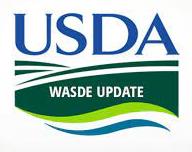 OVERVIEW OVERVIEW
The USDA provided updated projections for the production of corn and soybeans in the June12th World Agriculture Supply and Demand Estimates (WASDE) #661, reflecting the 2025 crop. Production values for corn and soybeans were understandably unchanged from the May edition. Projections of crop size and ending stocks are derived from acreage to be planted, recent annual crop yields and with the latest assumptions relating to domestic use and tariff policy influencing exports.
The June 12th WASDE report confirmed that the 2025 corn crop will be harvested from an expanded 87.4 million acres, (82.7 million acres in 2024). The soybean crop will be harvested from a reduced 82.7 million acres, (86.3 million acres in 2024).
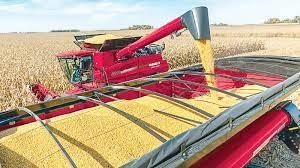 The June 12th WASDE yield value for the 2025 corn crop was predicted at 181.0 bushels per acre. By comparison yield was 183.1 bushels per acre in 2024. The projected value for soybean yield was an optimistic 52.5 bushels per acre compared to 51.7 bushels per acre for the previous crop. The June 12th WASDE yield value for the 2025 corn crop was predicted at 181.0 bushels per acre. By comparison yield was 183.1 bushels per acre in 2024. The projected value for soybean yield was an optimistic 52.5 bushels per acre compared to 51.7 bushels per acre for the previous crop.
The June 12th USDA projection for the ending stock of corn was reduced 2.8 percent to 1,750 million bushels due to a corresponding reduction in beginning stock. The June USDA projection for the ending stock of soybeans was unchanged at 295 million bushels.
The June 12th 2024 WASDE projected the corn price for the 2025-2026 market year at an average of 420 cents per bushel. The projected average season price for soybeans was 1,025 cents per bushel. The price of soybean meal was unchanged at $310 per ton. USDA commodity prices suggest stable to lower feed costs for livestock and poultry producers. Row crop farmers will experience declining margins. In some areas corn will be below break-even given relative production costs and per bushel prices. It is probable that high support prices will be required from Commodity Credit Corporation funding if importing nations respond negatively to protective and punitive tariffs imposed by the Administration.
Projections for world output included in the June 2025 WASDE report, reflect the most recent estimates for the production and export of commodities especially in the Southern Hemisphere with an emphasis on Argentine and Brazil. Economists also evaluated the likely impacts from the ongoing La Nina event especially on South America.
It is accepted that USDA projections for export will be influenced by the fluid situation relating to tariffs. Exports are also based on the perceived intentions and needs of China. This Nation has sharply curtailed purchases of commodities and especially U.S. soybeans during the previous and current market years.
CORN
Production parameters for corn were unchanged from the June Report. Influenced by harvest data for the 2024 crop and the March 31st Prospective Plantings Report, the June WASDE Report projected a 2025 crop of 15,820 million bushels, compared to 15,413 million bushels for the previous 2024 record harvest. The “Feed and Residual” category was retained at 5,900 million bushels. As of 9th June, 97 percent of the corn crop had been planted with 87 percent emerged. The Food and Seed category was held at 1,385 million bushels. The Ethanol and Byproducts Category was unchanged at 5,500 million bushels consistent with estimated demand for E-10 and higher blends and onset of summer driving. Projected corn exports were predicted to attain 2,675 million bushels, based on recent orders and shipments. The anticipated ending stock of corn will be 1,750 million bushels or 10.2 percent of projected availability.
The forecast USDA average season farm price for corn in the June WASDE report covering the 2025 crop was 420 cents per bushel. At 16H00 EDT on June 12th after the noon release of the WASDE, the CME spot price for corn was 439 cents per bushel, 4.5 percent above the USDA June projection.
JUNE 2025 WASDE #661 Projections for the 2025 Corn Harvest:
|
Harvest Area
|
87.4 m acres
|
(95.3 m. acres planted), harvest corresponding to 91.7% of acres planted)
|
|
Yield
|
181.0 bushels per acre
|
(Updated from 179.3 bushels per acre in the February WASDE reflecting the 2024 crop)
|
|
Beginning Stocks
|
1,365 m. bushels
|
|
|
Production
|
15,820 m. bushels
|
|
|
Imports
|
25 m. bushels
|
|
|
Total Supply
|
17,210 m. bushels
|
Proportion of Supply
|
|
Feed & Residual
|
5,900 m. bushels
|
34.3%
|
|
Food & Seed
|
1,385 m bushels
|
8.0%
|
|
Ethanol & Byproducts
|
5,500 m. bushels
|
32.0%
|
|
Domestic Use
|
12,785m. bushels
|
74.3%
|
|
Exports
|
2,675 m. bushels
|
15.5%
|
|
Ending Stocks
|
1,750 m. bushels
|
10.2%
|
Average Farm Price: 420 cents per bushel. (Unchanged from May)
SOYBEANS
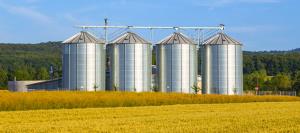 Production parameters for soybeans were unchanged from the June Report. Influenced by harvest data for the 2024 corn crop and an estimated yield of 52.5 bushels per acre albeit with reduced acreage planted, the June WASDE Report projected the soybean harvest to be 4,340 million bushels. As of 9th June, 90 percent of the soybean crop had been planted with 75 percent emerged. Crush volume was projected at 2,490 million bushels despite increased industry capacity. Projected exports were predicted to be 1,815 million bushels notwithstanding the prospect of reduced imports by China following uncertainty over tariffs. Ending stocks were anticipated to be 295 million bushels, down 22.3 percent from the December WASDE report reflecting the 2024-2025 season. Prior to 2018, China, the largest trading partner for U.S. agricultural commodities, imported the equivalent of 25 percent of U.S. soybeans harvested. Production parameters for soybeans were unchanged from the June Report. Influenced by harvest data for the 2024 corn crop and an estimated yield of 52.5 bushels per acre albeit with reduced acreage planted, the June WASDE Report projected the soybean harvest to be 4,340 million bushels. As of 9th June, 90 percent of the soybean crop had been planted with 75 percent emerged. Crush volume was projected at 2,490 million bushels despite increased industry capacity. Projected exports were predicted to be 1,815 million bushels notwithstanding the prospect of reduced imports by China following uncertainty over tariffs. Ending stocks were anticipated to be 295 million bushels, down 22.3 percent from the December WASDE report reflecting the 2024-2025 season. Prior to 2018, China, the largest trading partner for U.S. agricultural commodities, imported the equivalent of 25 percent of U.S. soybeans harvested.
The USDA WASDE June projection for the ex-farm price for soybeans for the 2025 harvest was 1,025 cents per bushel. At 16H00 EDT on June 12th following release of the WASDE, the CME spot price was 1,042 cents per bushel, 1.6 percent above the June USDA projection.
JUNE 2025 WASDE #661 Projection for the 2025 Soybean Harvest:-
|
Harvest Area
|
82.7 m acres
|
83.5 m. acres planted. Harvest corresponding to 99.0% of planted acreage)
|
|
Yield
|
52.5 bushels per acre
|
(Up from 51.7 bushel/acre attained in 2024)
|
|
Beginning Stocks
|
350 m. bushels
|
|
|
Production
|
4,340 m. bushels
|
|
|
Imports
|
20 m. bushels
|
|
|
Total Supply
|
4,710 m. bushels
|
Proportion of Supply
|
|
Crush Volume
|
2,490 m. bushels
|
52.9%
|
|
Exports
|
1,815 m. bushels
|
38.5%
|
|
Seed
|
73 m. bushels
|
1.5%
|
|
Residual
|
37 m. bushels
|
0.8%
|
|
Total Use
|
4,415 m. bushels
|
93.7%
|
|
Ending Stocks
|
295 m. bushels
|
6.3%
|
Average Farm Price: 1,025 cents per bushel (Unchanged from May)
SOYBEAN MEAL
 Production parameters for soybean meal were unchanged from the June Report. The projected production of soybean meal from the 2025 soybean crop will be 58.7 million tons, consistent with the soybean crush volume of 2,490 million bushels. Projected production reflects the stagnant demand for biodiesel despite expanded U.S. crushing capacity. According to NOPA crush volumes in March and April were respectively 194.5 and 190.2 million bushels. Crush volume is driven both by exports and domestic consumption for livestock feed and for soy oil supplying the food and biodiesel segments. The projection of domestic use was 41,325 million tons. Exports were estimated at 18.0 million tons. Production parameters for soybean meal were unchanged from the June Report. The projected production of soybean meal from the 2025 soybean crop will be 58.7 million tons, consistent with the soybean crush volume of 2,490 million bushels. Projected production reflects the stagnant demand for biodiesel despite expanded U.S. crushing capacity. According to NOPA crush volumes in March and April were respectively 194.5 and 190.2 million bushels. Crush volume is driven both by exports and domestic consumption for livestock feed and for soy oil supplying the food and biodiesel segments. The projection of domestic use was 41,325 million tons. Exports were estimated at 18.0 million tons.
The USDA projected the ex-plant price of soybean meal at $310 is unchanged since the February WASDE as an average for the season based on supply and demand considerations. USDA predicted an ending stock of 475,000 tons representing 0.8 percent of supply.
At 16H00 EDT on June 12th the CME spot price for soybean meal was $295 per ton, down 5.1 percent compared to the May WASDE projection of $310 per ton.
JUNE 2025 WASDE #661 Projection of Soybean Meal Production and Use
|
Beginning Stocks
|
450
|
|
Production
|
58,700
|
|
Imports
|
650
|
|
Total Supply
|
59,800
|
|
Domestic Use
|
41,325
|
|
Exports
|
18,000
|
|
Total Use
|
59,325
|
|
Ending Stocks
|
475
|
(Quantities in thousand short tons)
Average Price ex plant: $310 per ton (Unchanged from May)
IMPLICATIONS FOR PRODUCTION COST
The price projections based on CME quotations for corn and soybeans suggest lower feed production costs for broilers and eggs. Going forward, prices of commodities will be determined by World supply and demand and U.S. domestic yield, use and exports.
For each 10 cents per bushel change in corn:-
- The cost of egg production would change by 0.45 cent per dozen
- The cost of broiler production would change by 0.25 cent per live pound
For each $10 per ton change in the cost of soybean meal:-
- The cost of egg production would change by 0.35 cent per doze
- The cost of broiler production would change by 0.30 cent per live pound.
WORLD SITUATION
With respect to world coarse grains and oilseeds the June 2025 WASDE Report included the following appraisals by USDA:-
COARSE GRAINS:
“Global coarse grain production for 2025/26 is forecast 1.2 million tons higher to 1.551 billion. This month’s foreign coarse grain outlook is for larger production and trade, and smaller ending stocks relative to last month. Foreign corn production is higher with an increase for India. Foreign barley production is up slightly, reflecting increases for the EU and Argentina that are partly offset by a decline for Syria”.
“Major global trade changes for 2025/26 include larger barley exports for Argentina. For 2024/25, corn exports are lowered for Argentina but raised for the United States and Canada. Corn imports are lowered for China and Canada with increases for Turkey, Indonesia, and Iraq. Foreign corn ending stocks for 2025/26 are reduced, with cuts to China, South Africa, India, and Canada partially offset by an increase for Argentina.
OILSEEDS:
“Global soybean supply and demand forecasts for 2025/26 include higher beginning stocks, unchanged production, slightly higher crush, and higher ending stocks. Beginning stocks are raised on a one-million-ton reduction to crush for China in the prior marketing year, guided by the slower-than-expected reported weekly pace to date. Crush for 2025/26 is raised 0.1 million tons on higher use by Pakistan, South Africa, and the United Kingdom”.
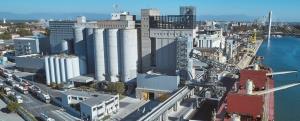
“With exports unchanged, global ending stocks are raised 1.0 million tons to 125.3 million, mainly on higher stocks for China. Another notable revision is higher palm oil production for Malaysia for 2024/25 and 2025/26 based on an expected recovery after widespread flooding impacted operations earlier in the year”.
World and U.S. Data Combined for Coarse Grains and Oilseeds:-
|
Factor: Million m. tons
|
Coarse Grains
|
Oilseeds
|
|
Output
|
1,551*
|
692
|
|
Supply
|
1,865
|
834
|
|
World Trade
|
238
|
215
|
|
Use
|
1,562
|
581
|
|
Ending Stocks
|
302
|
144
|
*Values rounded to one million metric ton
(1 metric ton corn= 39.37 bushels. 1 metric ton of soybeans = 36.74 bushels)
(“ton” represents 2,000 pounds)

|
Broiler Month
|
12/23/2024 |
|
Monthly Broiler Production and Prices, December 2024.
Broiler Chick Placements.
According to the December 18th 2024 USDA Broiler Hatchery Report, 990.42 million eggs were set over four weeks extending from November 23rd 2024 through December 14th 2024 inclusive. This was three percent higher compared to the corresponding period in 2023.
Total chick placements for the U.S. over the five-week period amounted to 764.16 million chicks. Claimed hatchability for the period averaged 79.7 percent for eggs set three weeks earlier, unchanged from the preceding five-week period. Each 1.0 percent change in hatchability represents approximately 1.91 million chicks placed per week and 1.82 million broilers processed, assuming five percent culls and mortality and with the current range of weekly settings.
Cumulative chick placements for the period January 7th through December 30th 2023 amounted to 9.67 billion chicks. For January 6th through December 14th 2024 chick placements attained 9.46 billion, up two percent from the corresponding week in 2023.
According to the December 20th 2024 edition of the USDA Chickens and Eggs, pullet breeder chicks hatched and intended for U.S. placement during November 2024 amounted to 8.26 million, up 0.7 percent (56,000 pullet chicks) from November 2023 and 2.5 percent (205,000 pullet chicks) more than the previous month of October 2024. Broiler breeder hen complement attained 60.88 million on November 1st 2024, 2.7 percent (1.74 million hens) less than on November 1st 2023.
Broiler Production
As documented in the December 20th 2024 USDA Broiler Market News Reports for the processing week ending December14th 2024, 166.6 million broilers were processed at 6.53 lbs. live. This was 1.9 percent less than the 169.9 million broilers processed during the corresponding week in the previous month of November 2024 and 0.6 percent less than the 167.6 million processed during the corresponding week in December 2023. Broilers processed in 2024 to date amounted to 8,200 million, 1.3 percent lower than for the corresponding period in 2023.
Ready to cook (RTC) weight for the most recent week in December was 830.8 million lbs. (377,639 metric tons). This was 1.8 percent less than the 845.9 million lbs. processed during the corresponding week in November 2024 and 0.8 percent more than the 824.1 million lbs. during the corresponding week in December 2023. Dressing percentage was a nominal 76.0 percent. For 2024 to date RTC broiler production attained 40,607 million lbs. (18.46 million metric tons). This quantity was 0.6 percent more than for the corresponding period in 2023.
Broiler Prices
The USDA National Composite Weighted Wholesale price for the week ending December 20th 2024 was up 4.6 cents per lb. to 132.6 cents per lb. from the corresponding week in November 2024. The attached USDA figures denote average prices over three-years.
Leading QSRs are using increasing quantities of breast meat for sandwiches, strips and nuggets. Inflation is increasing consumer awareness of value with chicken benefitting at the expense of beef and pork
 
|
Turkey Month
|
12/23/2024 |
|
Monthly Turkey Production and Prices, December 27th 2024
Poult Production and Placement:
The December 13th 2024 edition of the USDA Turkey Hatchery Report, issued monthly, documented 24.66 million eggs in incubators on December 1st 2024 compared to 25.35 million eggs on December 1st 2023* The December 2024 set was down 0.68 million eggs (2.7 percent) from December 2023 and 0.19 million eggs (0.8 percent) from than the previous month of November 2024.
A total of 21.02 million poults were hatched during November 2024 down 0.65 million poults (3.0 percent) compared to 21.67 million in November 2023*. The November 2024 hatch was almost unchanged (down 4,000 poults) from the previous month of October.
A total of 19.27 million poults were placed on farms in the U.S. in November 2024, compared to 19.94 million in November 2023*. The November 2024 placement was 0.67 million poults (3.4 percent) less than in October 2023. The November placement was 0.11 million higher than the previous month of October. This data confirms disposal of 1.75 million poults during the month. Approximately 8.3 percent of the November 2024 hatch was not placed.
For the twelve-month period December 2023 through November 2024 inclusive, 252.03 million poults were hatched and 235.42 million were placed. This confirms disposal of 16.61 million poults over the 12-month period, corresponding to 6.6 percent of all poults hatched.
* USDA revision from previous monthly report.
Turkey Production:
The December 20th 2024 edition of the Turkey Market News Reports documented the following provisional data for turkeys slaughtered under Federal inspection:-
- For the processing week ending December 14th 2024, 1.393 million hens were processed at 17.7 lbs. live. This was 37.9 percent less than the 2.242 million hens processed during the corresponding week in November 2024 and 21.1 percent more than the 1.765 million processed during the corresponding week in December 2023. Hen slaughter year-to-date has attained 81.1 million, 11.3 percent less than for the corresponding period in 2023.
- Ready to cook (RTC) weight for hens over the most recent week was 19.83 million lbs. (9,012 metric tons). This quantity was 29.8 percent less than the 28.25 million lbs. for corresponding week in November 2024 and 9.7 percent less than the 21.97 million lbs. during the corresponding week in December 2023. Dressing percentage was a nominal 80.5 percent. For 2024 to date RTC hen production attained 1,111 million lbs. (504,836 metric tons). This quantity is 11.1 percent less than for the corresponding period in 2023.
- For the processing week ending December 14th 2024, 1.974 million toms were processed at 43.4 lbs. live. This was 4.6 percent less than the 2.070 million toms processed during the corresponding week in November 2024 and 8.1 percent less than the 2.148 million during the corresponding week in December 2023. Year-to-date 99.75 million toms have been processed, 0.9 percent less than for the corresponding period in 2023.
- Ready to cook (RTC) weight for toms during the most recent week was 69.0 million lbs. (31,356 metric tons). This quantity was 0.5 percent less than the 72.7 million lbs. processed during the corresponding week in November 2024 and 9.5 percent less than the 76.2 million lbs. during the corresponding week in December 2023. Dressing percentage was a nominal 80.5 percent. For 2024 to date RTC tom production attained 3,559 million lbs. (1.618 million metric tons). This quantity is less than 0.1 percent more than the corresponding period in 2023.
Wholesale Prices
The National average frozen hen price (8 to 16 lbs.) for conventional birds during the week ending December 20th was 104.0 cents per lb., 7.7 cents per lb. above than the previous month in 2024 and down 20 cents per lb. from the three-year average of approximately 124 cents per lb. The following prices rounded to the nearest cent were documented in the new format report for domestic and export trading for December 2024 as reported on December 20th:-
|
Product
|
cents per lb.
|
Change from previous Month (%)
|
|
Frozen hens whole Grade A (8-16 lb)
|
104
|
+8.3
|
|
Frozen toms whole Grade A (16-24 lb)
|
105
|
+11.7
|
|
Thighs (bone in)
|
Not listed
|
-
|
|
Necks (toms, export)
|
104
|
+7.7
|
|
Breasts 4-8 lb. (fresh)
|
Not listed
|
-35.8
|
|
Breasts B/S (toms, fresh)
|
165
|
-
|
|
Drums (toms)
|
114
|
+4.6
|
|
Wings (full-cut tom)
|
112
|
+4.7
|
|
Tenderloins
|
218
|
+67.6
|
|
Thigh Meat (skin and boneless)
|
191
|
+3.2
|
|
Mechanically Separated (domestic)
(export)
|
52
Not listed
|
+8.3
-
|
 
|
Meat Projection Dec 2024
|
12/20/2024 |
|
 Updated USDA-ERS Poultry Meat Projection for December 2024. Updated USDA-ERS Poultry Meat Projection for December 2024.
On December 16th 2024 the USDA-Economic Research Service released updated production and consumption data with respect to broilers and turkeys, covering 2023 an update of 2024 and a forecast for 2025.
The 2024 projection for broiler production is 47,187 million lbs. (21.449 million metric tons) up 1.7 percent from 2023. USDA projected per capita consumption of 102.3 lbs. (46.5 kg.) for 2024, up 2.8 percent from 2023. Exports will attain 6,742 million lbs. (3.065 million metric tons), 7.5 percent below the previous year.
The 2025 USDA forecast for broiler production will be 47,925 million lbs. (21.7984 million metric tons) up 1.6 percent from 2024 with per capita consumption up 1.0 lb. to 103.3 lbs. (47.0 kg). Exports will be 0.8 percent higher compared to 2024 at 6,795 million lbs. (3.089 million metric tons), equivalent to 14.2 percent of production.
Production values for the broiler and turkey segments of the U.S. poultry meat industry are tabulated below:-
|
Parameter
|
2023
(actual)
|
2024
(projection)
|
2025
(forecast)
|
Difference
2024 to 2025
|
|
Broilers
|
|
|
|
|
|
Production (million lbs.)
|
46,387
|
47,187
|
47,925
|
+1.6
|
|
Consumption (lbs. per capita)
|
99.5
|
102.3
|
103.3
|
+1.0
|
|
Exports (million lbs.)
|
7,260
|
6,742
|
6,795
|
+0.8
|
|
Proportion of production (%)
|
15.7
|
14.3
|
14.2
|
-0.7
|
|
|
|
|
|
|
|
Turkeys
|
|
|
|
|
|
Production (million lbs.)
|
5,457
|
5,147
|
5,145
|
< -0.1
|
|
Consumption (lbs. per capita)
|
14.8
|
14.0
|
13.7
|
-2.1
|
|
Exports (million lbs.)
|
490
|
502
|
530
|
+2.9
|
|
Proportion of production (%)
|
9.0
|
9.8
|
9.7
|
-1.0
|
Source: Livestock, Dairy and Poultry Outlook released December 16th 2024
The December USDA report updated projection for the turkey industry for 2024 including annual production of 5,147 million lbs. (2.340 million metric tons), down 3.7 percent from 2023. Consumption in 2024 is projected to be 14.0 lbs. (6.4 kg.) per capita, down 5.7 percent from the previous year. Export volume will increase by 2.5 percent in 2024 to 502 million lbs. (228,000 metric tons). Values for production and consumption of RTC turkey in 2024 are considered to be realistic, given year to date data, the prevailing economy, variable weekly poult placements, production levels, limited losses from HPAI and inventories consistent with season.
 The 2025 forecast for turkey production is 5,145 million lbs. (2.339 million metric tons) down 0.1 percent from 2024 with per capita consumption down 2.1 percent to 13.7 lbs. (6.2 kg). Exports will be 5.6 percent higher than in 2024 to 530 million lbs. (240,910 metric tons) equivalent to 9.7 percent of production. The 2025 forecast for turkey production is 5,145 million lbs. (2.339 million metric tons) down 0.1 percent from 2024 with per capita consumption down 2.1 percent to 13.7 lbs. (6.2 kg). Exports will be 5.6 percent higher than in 2024 to 530 million lbs. (240,910 metric tons) equivalent to 9.7 percent of production.
Export projections do not allow for a breakdown in trade relations with existing major partners including Mexico, Canada and China nor the impact of catastrophic diseases including HPAI and vvND in either the U.S. or importing nations
Compared to 2023 exports of broiler products to China during 2024 were 34 percent lower in volume to 405,343 metric tons and 34 percent lower in value to $711 million. For the first half of 2024 broiler volume to 4th-ranked China was down 62 percent from the corresponding months in 2023 to 92,069 metric tons. Value was down 54 percent to $183 million.

|
Turkey Month
|
11/25/2024 |
|
Monthly Turkey Production and Prices, November 27th 2024
Poult Production and Placement:
The November 17th 2024 edition of the USDA Turkey Hatchery Report, issued monthly, documented 24.98 million eggs in incubators on November 1st 2024 compared to 25.54 million eggs on November 1st 2023* The November 2024 set was down 0.56 million eggs (2.2 percent) from November 2023 and 32,000 eggs (less than 0.1 percent percent) from than the previous month of October 2024.
A total of 20.73 million poults were hatched during October 2024 down 1.94 million poults (8.5 percent) compared to 22.67 million in October 2023*. The October 2024 hatch was up 0.50 million poults (2.5 percent) from the previous month of September.
A total of 18.77 million poults were placed on farms in the U.S. in October 2024, compared to 20.65 million in October 2023*. The October 2024 placement was 0.85 million poults (4.7 percent) more than in September 2024. This data confirms disposal of 1.96 million poults during the month. Approximately 9.5 percent of the October 2024 hatch was not placed.
For the twelve-month period November 2023 through October 2024 inclusive, 252.39 million poults were hatched and 235.70 million were placed. This confirms disposal of 16.69 million poults over the 12-month period, corresponding to 6.6 percent of all poults hatched.
* USDA revision from previous monthly report.
P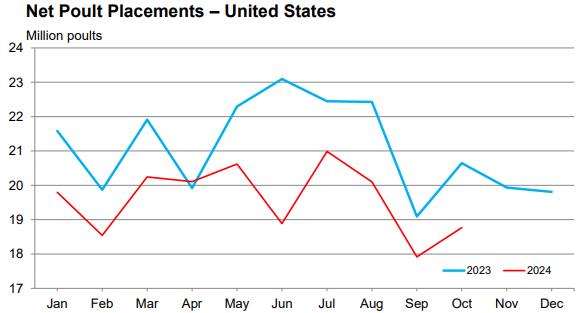 |
 
|
Meat Exports
|
11/19/2024 |
|
U.S. Broiler and Turkey Exports, January-September 2024.
OVERVIEW
 Total exports of bone-in broiler parts and feet during January-September 2024 attained 2,441,412 metric tons, 10.5 percent lower than in January-September 2023 (2,728,128 metric tons). Total value of broiler exports decreased by 3.0 percent to $3,441 million ($3,548 million). Total exports of bone-in broiler parts and feet during January-September 2024 attained 2,441,412 metric tons, 10.5 percent lower than in January-September 2023 (2,728,128 metric tons). Total value of broiler exports decreased by 3.0 percent to $3,441 million ($3,548 million).
Total export volume of turkey products during January-September 2024 attained 164,124 metric tons, 4.9 percent more than in January-September 2023 (156,421 metric tons). Total value of turkey exports increased by 8.6 percent to $490.5 million ($451.6 million).
Unit price for the broiler industry is constrained by the fact that leg quarters comprise over 96 percent of broiler meat exports by volume (excluding feet). From the first quarter of 2021 through late 2022, the value of leg quarters increased in unit value consistent with international demand but followed by a decline in 2023. Leg quarters represent a relatively low-value undifferentiated commodity lacking in pricing power. Exporters of commodities are subjected to competition from domestic production in importing nations. Generic products such as leg quarters are vulnerable to trade disputes and embargos based on real or contrived disease restrictions. To increase sales volume and value the U.S. industry will have to become more customer-centric following the lead of Brazil offering value-added presentations with attributes required by importers. Whether this will increase margins is questionable given the by-product contribution of leg quarters. A more profitable strategy for the U.S. industry would be to develop products using dark meat to compete with and displace pork and beef in the domestic retail and institutional markets.

HPAI is now accepted to be a panornitic affecting the poultry meat industries of five continents with seasonal and sporadic outbreaks. The incidence rate and location of cases in the U.S. limits eligibility for export depending on restrictions imposed by importing nations
Ongoing outbreaks of African swine fever in China and Southeast Asia from early 2019 and Europe from 2020 onwards reduced the availability of pork. In addition, disruptions in chicken production and logistics due to COVID restrictions decreased availability of protein with international repercussions on trade in chicken and pork. The demand for pork imports to China has diminished with restoration of domestic hog production to the extent of overproduction. Mild oversupply is evident in the white-feathered broiler sector with implications for exports other than feet extending into 2024.
 
|
Poultry Meat Projection September 2024
|
09/20/2024 |
|
 Updated USDA-ERS Poultry Meat Projection for September 2024. Updated USDA-ERS Poultry Meat Projection for September 2024.
On September 18th 2024 the USDA-Economic Research Service released updated production and consumption data with respect to broilers and turkeys, covering 2023 a projection for 2024 and a forecast for 2025.
The 2024 projection for broiler production is 47,109 million lbs. (21.403 million metric tons) up 1.6 percent from 2023. USDA projected per capita consumption of 102.0 lbs. (46.4 kg.) for 2024, up 2.6 percent from 2023. Exports will attain 6,766 million lbs. (3.075 million metric tons), 6.7 percent below the previous year.
The 2025 USDA forecast for broiler production will be 47,675 million lbs. (21.670 million metric tons) up 1.2 percent from 2024 with per capita consumption up 0.5 lb. to 102.5 lbs. (46.6 kg). Exports will be 1.6 percent higher compared to 2024 at 6,875 million lbs. (3.125 million metric tons), equivalent to 14.5 percent of production.
Production values for the broiler and turkey segments of the U.S. poultry meat industry are tabulated below:-
|
Parameter
|
2023
(actual)
|
2024
(projection)
|
2025
(forecast)
|
Difference
2023 to 2024
|
|
Broilers
|
|
|
|
|
|
Production (million lbs.)
|
46,387
|
47,109
|
47,675
|
+1.6
|
|
Consumption (lbs. per capita)
|
99.5
|
102.0
|
102.5
|
+2.5
|
|
Exports (million lbs.)
|
7,260
|
6,776
|
6,875
|
-6.8
|
|
Proportion of production (%)
|
15.7
|
14.4
|
14.4
|
-8.3
|
|
|
|
|
|
|
|
Turkeys
|
|
|
|
|
|
Production (million lbs.)
|
5,457
|
5,130
|
5,175
|
-6.0
|
|
Consumption (lbs. per capita)
|
14.8
|
13.9
|
13.8
|
-6.1
|
|
Exports (million lbs.)
|
490
|
507
|
530
|
+3.5
|
|
Proportion of production (%)
|
9.0
|
9.9
|
10.2
|
+10.0
|
Source: Livestock, Dairy and Poultry Outlook released September 18th 2024
The September USDA report updated projection for the turkey industry for 2024 including annual production of 5,130 million lbs. (2.332 million metric tons), down 6.0 percent from 2023. Consumption in 2024 is projected to be 13.9 lbs. (6.3 kg.) per capita, down 6.1 percent from the previous year. Export volume will increase by 3.5 percent in 2024 to 507 million lbs. (230,455 metric tons). Values for production and consumption of RTC turkey in 2024 are considered to be realistic, given year to date data, the prevailing economy, variable weekly poult placements, production levels, freedom from HPAI and inventories.

The 2025 forecast for turkey production is 5,175 million lbs. (2.352 million metric tons) up 1.2 percent from 2024 with per capita consumption down 0.7 percent to 13.8 lbs. (6.3 kg). Exports will be 5.0 percent higher than in 2024 to 530 million lbs. (240,910 metric tons) equivalent to 10.0 percent of production.
Export projections do not allow for a breakdown in trade relations with existing major partners including Mexico, Canada and China nor the impact of catastrophic diseases including HPAI and vvND in either the U.S. or importing nations
Compared to 2022 exports of broiler products to China during 2024 were 34 percent lower in volume to 405,343 metric tons and 34 percent lower in value to $711 million. For the first half of 2024 broiler volume to 4th-ranked China by volume of imports was down 62 percent from the corresponding months in 2023 to 92,069 metric tons. Value was down 54 percent to $183 million
Subscribers are referred to the monthly export report in this edition and update of production data and cold storage inventories of broilers and turkeys respectively posted in each end-of- month edition of CHICK-NEWS with the previous monthly data under the STATISTICS tab.

|
USDA Export Projections For Chicken
|
09/02/2022 |
|
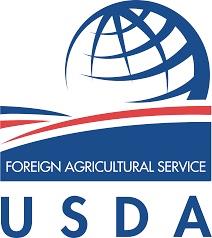 Based on the August 12th, 2022 World Agricultural Supply and Demand Estimates, USDA has projected chicken exports for 2022 with a forecast for 2023. Based on the August 12th, 2022 World Agricultural Supply and Demand Estimates, USDA has projected chicken exports for 2022 with a forecast for 2023.
Broiler meat exports will amount to 3.3 million metric tons in 2022 valued at $4.2 billion. For 2023, volume and value will be unchanged, representing a unit price excluding feet, which are not federally inspected, at $1,272 per metric ton.
 The 2023 exports of all agricultural products will amount to $193.5 billion in 2023, balanced by imports of $197.0 billion resulting in a negative annual balance of $3.5 billion. The 2023 exports of all agricultural products will amount to $193.5 billion in 2023, balanced by imports of $197.0 billion resulting in a negative annual balance of $3.5 billion.
|
|
|
|

|
| |
Copyright © 2025 Simon M. Shane
|
|
|